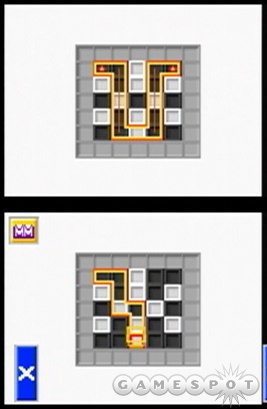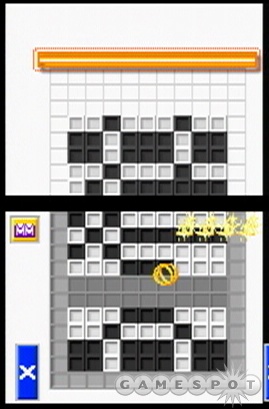Polarium is a puzzle game named for its play off of the concept of polarity. Similar to Ikaruga, Polarium is all about switching the polarity of things from light to dark and back again as the situation dictates. It's awfully plain-looking, and some of its modes aren't much fun. However, the game's puzzle mode and the ability to create and share your own puzzles does give Polarium a lot of appeal to fans of brainteasers.

There are two or three different ways to take on Polarium, but the rules remain roughly the same between modes. You're given a playfield full of light and dark tiles, and you can flip them over by drawing lines with the stylus. When you create a horizontal row of all one color, it disappears. The object is to draw long, snaking lines that will create multiple solid lines at the same time, potentially clearing the entire screen in one fell swoop. That concept works a little differently in each mode. Challenge mode tries to bring it like Tetris, giving you a well and dropping multiple mixed-up rows at you at set intervals. Most of what drops on you is dropped in some sort of pattern that can be cleared in one line, if you're fast enough. Play ends when both your screens are stacked with tiles. This is the weakest of the three modes, because it just comes down to how quickly can recognize and eliminate the handful of patterns that are repeatedly tossed your way. Versus mode lets two players go head-to-head. Here, the lines you eliminate are sent to your opponent's screen, just as you'd expect from a multiplayer puzzle game. There are some attack items to earn, and the first player to clear his or her screen wins the match. This is a reasonably cool mode, but the main point of interest in Polarium is its puzzle mode.
Polarium has 100 preset puzzles for you to take on in order. Puzzle mode gives you a static screen full of tiles. All these tiles can be eliminated with just one stroke of the stylus, and it's up to you to figure out the proper path to victory. The first 20 or 25 puzzles warm you up, but past that mark, it starts to get pretty tough. You can enable a hint mode that will show you the starting and ending point of a successful line if you get trapped on any one puzzle for too long. These are some great brainteasers that really force you to think, and they're easily the best, most-rewarding part of the entire game.
Once you're finished with the puzzle mode--or once you get stuck--you can always turn to the lounge area, which lets you create your own puzzles. While creating your own puzzles isn't all that hot on its own--because you always have to provide a correct solution when you're making a puzzle--the game offers the ability to share your puzzles with others via wireless link or password. This means you can take to the streets or take to a message board and trade puzzles with other players. Challenging your friends to complete your own devious tasks is great fun that makes the whole package more worthwhile.

Graphically, Polarium isn't much to look at. The tiles are either light or dark, and there aren't any additional tilesets that come in to change up the look. It's very plain. The game's sound effects and music are similarly underwhelming, but at least they don't get on your nerves.
Fans of the puzzle genre aren't guaranteed to like Polarium. The modes that fall into line with other genre favorites are the weakest part of the package. But if staring at a brainteaser for lengthy periods of time is your idea of excitement, or if the idea of creating puzzles and sharing them with like-minded friends is intriguing to you, then you'll find enough enjoyable mind-benders to make this worth a purchase.